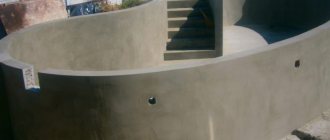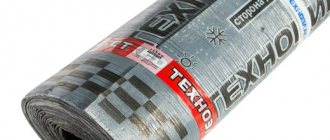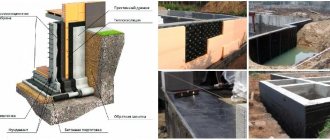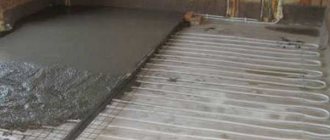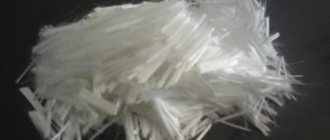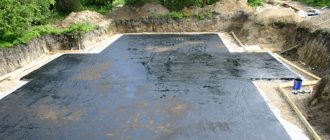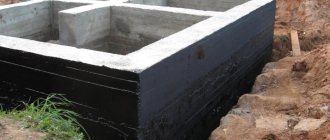There is no absolutely dry soil even in the desert, so a foundation unprotected from the destructive effects of water will not last long. In order to avoid frequent overhauls, protection measures are carried out at the stage of the zero cycle. Of all the moisture-proofing materials presented on the Russian market, TechnoNIKOL waterproofing for foundations is considered the best.
Installation of TechnoNIKOL floor waterproofing under tiles (without protective screed)
Horizontal mounting
1. You can begin laying the material only after the primer composition has completely dried on the base and on the material sheets prepared for installation. For ease of installation, prepared waterproofing strips can be rolled into rolls immediately before starting work.
2. Installation begins from the far corner of the room. The roll is gradually rolled out with the adhesive side over the surface, removing the adhesive film as it goes. The already glued waterproofing needs to be additionally rolled with a roller, this will help to avoid possible bubbles or waves.
3. During installation, make sure that in places of transverse and longitudinal overlaps, the lower sheet of material must be treated with a primer.
4. The discrepancy between the end overlaps of adjacent rolls must be at least 50 cm.
Installation on a vertical surface.
1. Carefully removing the protective film, lay the material on the wall, smooth it, press it and roll it with a stitching roller. Make sure that the material adheres well to the surface.
2. Remove the protective film of the part of the element that is on the floor and glue it in the same way. .
3. To reinforce internal and external corners, use triangular patterns made from self-adhesive waterproofing. Pre-treat the corners with a primer, after complete drying, place the waterproofing patterns on the corners and carefully roll them to the base.
Types of foundation waterproofing
Depending on the purpose of the building, anti-filtration and anti-corrosion insulation is distinguished. The first option, as a rule, is used for buildings of complex design, subject to heavy loads and erected on an area with excessively wet soil. Organization of anti-filtration waterproofing by a non-specialist is hardly possible; this very complex process can only be done by highly qualified specialists with extensive experience in this matter.
Anti-corrosion waterproofing is more popular and is much easier to install. This type of work can be horizontal and vertical. Vertical waterproofing will protect the walls of the building from water entering from the sides, and horizontal waterproofing will prevent capillary drawing in of water.
Waterproofing methods:
- plastering;
- pasting;
- coating
Plaster-type waterproofing is formed from composite materials laid in several layers with a total thickness of no more than 21 mm. Experts consider mineral-cement mortar with the addition of polymer concrete and various asphalt mastics to be the most popular and in demand.
Pasted waterproofing is organized from special waterproof membranes with a total thickness of up to 5 mm. Such materials include roofing felt or bitumen polymers, which have good adhesion, are supplied in rolls and are available to a wide range of consumers.
Coating-type waterproofing refers to various waterproof coatings, the total density of which should not be more than 3 mm. To organize this type of insulation, a variety of bitumen mastics with the addition of polymers, emulsions, solutions, and polymer-cement mixtures (elastic and rigid) are used. The TechnoNikol corporation specializes in the production of the last two types of products.
Rolled roofing and waterproofing materials TECHNONICOL
TechnoNIKOL Corporation offers construction organizations a wide selection of products for roofing and waterproofing. Various tasks and requirements of construction organizations dictate the availability of materials of different classes and price offers on the market. For ease of selection, TechnoNIKOL bitumen and bitumen-polymer materials are divided into four categories.
Premium
Rolled materials of this class allow you to solve a wide range of problems that arise when working at critical facilities. They are where only exceptional reliability and additional guarantees are needed.
Business
Roll materials included in this class are reliable and allow you to get a guaranteed result - to make a reliable roof. This is confirmed by the experience of their use at a large number of facilities throughout the country.
Standard
Products of this class perfectly perform their main function: protect the building from water. Test results and experience in their use confirm their reliability and durability. A wide range of materials in this class will allow you to choose the most suitable one. Their quality and reliability are combined with an affordable price.
Economy
These are high-quality products that allow you to produce inexpensive roofing. Their use does not require the use of expensive equipment, and they are quite reliable.
Rolled waterproofing for floors
High-quality insulation of the floor from moisture penetration is not only protection against leaks, but also normalization of the level of humidity in the room, counteracting the development of fungi and mold, and preventing the destruction of the wooden base of the floor and foundation.
The construction market offers consumers a wide range of floor waterproofing products - from mastics and penetrating materials to injection waterproofing compounds. But roll coatings traditionally retain a leading position due to their availability and high strength.
The undoubted advantages of rolled waterproofing materials include:
- flexibility and elasticity of the isol, resistance to deformation and stretching;
- ease of installation;
- Can be used on any surface – wood, concrete, metal, stone;
- minimum drying time between laying layers of waterproofing.
It should be borne in mind that laying roll roofing will require preliminary preparation of the base. An unprepared floor is the reason for the rapid peeling of insulation and the penetration of moisture into the floor and between the ceilings.
Depending on the type of floor, various methods of installing waterproofing are used:
- sticker – suitable for all types of floors;
- fusing - used on concrete floors;
- flooring - used on wooden floors.
Before installing the rolled waterproofing material, it is advisable to completely remove the old coating. Ideally, it is recommended to clear the floor down to the concrete base. After thoroughly removing debris, dirt and dust, it is necessary to repair all existing chips and cracks, remove protrusions and burrs using a grinder. The concrete floor leveled with the building mixture should be dried for 24 hours and the surface should be sanded with coarse sandpaper.
When laying waterproofing on a wooden floor, you must make sure that all the boards are intact and there is no creaking or sagging of the floors. If necessary, it is recommended to repair the floor before installing waterproofing or replacing individual floorboards.
Before starting the main work, you need to round off the junction of the floor and the wall with cement mortar - this way the insulating material will be laid more evenly and will avoid kinks. After thorough drying, the floor is primed twice, and the junction of the wall and the floor is treated with a moisture-resistant compound or artificial rubber tape.
Before laying the waterproofing material, keep the material indoors for at least 24 hours. In this case, the roll must be unrolled or cut into pieces along the length of the room.
The method of fastening the waterproofing depends on the selected brand of material. When laying the insulating coating as a “flooring”, the individual panels should overlap one another with an overlap of 20-25 cm. The laid material is fixed with self-tapping screws or pressed against floorboards.
Installation of fused type roll waterproofing requires the use of a propane torch (temperature 145-1600C), with which the bottom layer will be melted and fixed to the floor
It is important to know that changing the recommended flame temperature in one direction or another can lead to rapid detachment of the insulating coating
When using the adhesive method of laying waterproofing, bitumen-polymer mastic or glue heated to a temperature of 25-250C is applied to the base of the floor. If the adhesive layer has already been applied to the coating, then additional treatment with mastic is not carried out. After laying, all joints of the panels are coated with glue, and the surface of the insulate is rolled with pressure rollers.
To reliably protect the room from moisture, it is recommended to use at least two layers of waterproofing, laying them at an angle of 900 to each other. After the coating has hardened, it is necessary to eliminate existing defects (air bubbles, unevenness) and begin laying concrete screed, ceramic tiles or other material.
Classification of rolled materials by insulating composition
In the production of rolled waterproofing coatings, the following materials can be used as the main protective ingredient:
- Bitumen composition - is a bitumen resin mixed with crushed basalt/shale chips. This coating is used for the manufacture of roofing felt, roofing felt, glass roofing felt.
- Bitumen-polymer composition - made with the addition of special additives to bitumen that increase its elasticity and heat resistance. Artificial rubber or artificial plastic act as modifiers. Additives help increase the resistance of bitumen to high temperatures and ultraviolet radiation. This type of coating is indispensable in regions with hot climates.
- Membrane insulation is the most high-tech material of the new generation. Made from high- or low-density polyethylene, PVC (polyvinyl chloride) or TPO (polyophene) and is a thin film, the thickness of which varies from 0.2 to 2 mm. Some types of membrane coating provide for the application of a corrugated layer, which gives a more effective result in adhesion to the solution.
Waterproofing membranes have a number of advantages:
- strength and resistance to external damage;
- durability – service life reaches 50 years;
- protection from corrosion, rotting, decomposition or exposure to aggressive liquids;
- possibility of use at various temperature conditions – from -400 C to +500 C;
- environmental Safety.
How to cover a garage roof with TechnoNIKOL with your own hands: laying rules and installation technology
Among others, butyl rubber waterproofing tape is considered an excellent choice because it is inexpensive and durable, easy to use, and has good technical performance. The tape is used for water and air insulation. The main function of the blind area is to protect the foundation from the negative effects of moisture, frozen soil and melting snow. The blind area will prevent the cold from penetrating to the base of the house.
To install the blind area, you can choose one of the following materials: polystyrene foam, penoizol or polystyrene foam. The work is carried out in several stages:. Insulation of a pile-screw foundation. Read about it here.
And so, let's summarize how it happened. Before the final, looking at the rainy weather out the window, I was thinking about whether to buy a burner with a cylinder or not. The cost of the kit is 5 thousand, renting a kit with a filled 12l cylinder... I covered the roof - I realized that I had no desire to mess around with it.
Before you start laying waterproofing material, you need to carry out a number of works to prepare the roof. Absolutely all these activities require seriousness and literacy from the performer, since the consequences of improper implementation of any points can be fatal, even high-quality waterproofing will not save.
Adhesive compositions
Pasted waterproofing of the foundation, as well as the installation of insulation of other areas, involves the treatment of horizontal, vertical or inclined surfaces with rolled materials by shrinking them onto special mastics or adhesive bases.
Adhesives are selected taking into account the structural composition of the adhesive membrane. Brizol, glassine and roofing felt interact with bitumen mastics, roofing felt and roofing felt are placed on tar compounds, and fiberglass, PVC and plastic flexible materials are attached to special adhesives and epoxy resins.
Plastic film insulation is mounted on synthetic glue and resin. To treat horizontal surfaces, perchlorovinyl glue is used; for vertical walls of rooms and basements, a paste based on synthetic rubber and bentonite clay is used. Bitumen compositions from which mastics are prepared are selected taking into account the temperature regime.
To prevent waterproofing material from sliding off basement walls and other vertical surfaces, the softening temperature of the bitumen base should be 25°C higher than the air temperature.
Ruberoid
Surely every person, even those unfamiliar with construction, has ever encountered roofing felt.
Since the times of the Soviet Union, this material remains the most popular when carrying out roofing work and waterproofing structures. Such popularity of the material is due to its low cost.
There are many types of roofing material brands, which differ in characteristics and scope of application.
Brands of roofing felt for foundation waterproofing:
- Rubemast. A type of built-up roofing material, which differs in the thickness of the binder composition and the cardboard base. Rubemast is used for roofing and waterproofing. It is highly resistant to cracking.
- Glass roofing felt. An analogue of rubemast, which is based on special fiberglass, which significantly improves the tensile properties of the material.
- Euroroofing material. It is made on a synthetic base on top of which a layer of polymer bitumen composition is applied. It is used similarly to all materials of this type.
Advantages and disadvantages of roofing felt
The advantages of roofing felt include its low cost and ubiquity. You can buy roofing felt at any construction market and store.
Along with several positive qualities, there are many negative properties of roofing felt that make this material not the best choice for waterproofing the foundation of modern buildings. For example, low strength characteristics and high flammability.
According to the installation technology, waterproofing using roofing felt must be replaced after five years of operation, which makes its use impractical.
Another not the best property of roofing material is destruction under the influence of sunlight. After prolonged exposure to sunlight, the material becomes brittle and breaks easily.
But despite all this, roofing felt is successfully used as a material for horizontal waterproofing of foundations.
Useful video
Installation of TechnoNIKOL flexible tiles in video instructions:
If you are puzzled by the choice of high-quality, strong roofing material that will “tightly” adhere to the slopes, give preference to proven brands. Thus, the TechnoNIKOL overlay roofing from a domestic manufacturer is considered one of the best in Russia. It is presented on the market in several types, for each individual roofing task.
Let's study it in more detail, how positive the reviews are, are there any shortcomings and what is the technology for working with such material. And our detailed master classes, expert advice and new video reviews will help you with this.
Real reviews from homeowners
You can see impressions of TechnoNIKOL products on the website of the manufacturing company, or open thematic construction forums.
A general analysis of reviews shows that the quality of the products meets the approved standards, and the materials perform the stated functions. You can place an order online and choose a convenient delivery method.
Not all customer comments are only positive; this only happens with dubious brands that remove the consumer’s negative reaction. TechnoNIKOL processes all received reactions to optimize production processes and better control the points of sale of materials.
TechnoNIKOL insulation coating is easy to use and properly performs its assigned functions. With a correctly conducted analysis of the building and the area, you can find the desired type of cladding. For independent use, you need to take a product from the appropriate category; its installation is simple and does not require hiring specialists or equipment.
Insulation of the base of the house with Technonikol:
Average score of ratings is more than 0
Share link
Comments There are no comments yet, but you could be the first...
Roll waterproofing
All roll waterproofing has a similar structure. In the middle there is a base, which is covered on both sides with bitumen or bitumen-polymer layers. Various materials can be used as the basis for rolled waterproofing products, on which the technical characteristics and durability depend.
So, the following can be used as a basis:
- cardboard,
- polyester fiber (marked “E”),
- fiberglass (“X”),
- fiberglass (“T”).
Cardboard as a base is used in the cheapest material - roofing felt. The service life of such a product is the shortest and is only 5-7 years. Polyester fiber, fiberglass and fiberglass are used in both budget and expensive ones and last much longer (from 5 to 50 years or more).
The treatment of the upper surface of the material is also important. It can be covered:
- fine-grained topping – sand (“M”),
- coarse-grained topping – stone chips (“K”),
- polymer film (“P”).
The lower (inner) surface of rolled waterproofing can be covered with:
- polymer film (“P”),
- fine-grained powder (“M”),
- special ventilation ducts forming a “breathing” layer (“B”),
- Adhesive layer for installation without heating (“K”).
Let us now take a closer look at the range of TechnoNIKOL roll products:
- Bikrost is insulation based on fiberglass or fiberglass. It is a budget option, and the minimum service life of such material is 5-10 years.
- Bipole is also a budget option. Its basis is polyester fiber.
- Linocrom is a product of the same price category and is produced both on the basis of fiberglass and fiberglass, and on polyester fiber. Like Bipol, the service life ranges from 5 to 15 years.
- Uniflex is a more expensive waterproofing option. It is used for all types of structures and has a protective coating of granite chips, while it has higher performance qualities, and its service life can be up to 25 years.
- Technoelast is the most durable material presented - a service life of more than 30 years. This line contains roll materials for both exterior and interior decoration. It includes:
- EPP - used on soils with seasonal soil movements and high groundwater levels.
- Alpha - additionally reinforced with a layer of foil and is used to prevent the possible release of radioactive radon gas.
- Barrier and Barrier Light. The second of them is used for interior decoration of basements. On its outer part there is a special coating for subsequent finishing.
- Bridge. It has high strength and is used to insulate the base of the foundation.
Range of waterproofing materials
produces insulation for different purposes and for different budgets.
There are standard professional products used by construction organizations - rolled, membrane PVC materials; heat and sound insulation; mastics; primers; foam, film coatings.
Retail items - materials for roofing, flooring, and walls of a house to protect the building from water, noise, and cold. They are easy to use, undemanding in the use of equipment and complex technologies. Suitable for self-construction of a private house or cottage.
Approximate range of finished products
The high-quality line with the “Premium” brand is made from the highest quality raw materials, which significantly improves the technical characteristics of the insulating components and increases the service life. The category includes rolls, PVC membranes, polymers, mastics, PIR.
The “Architect” line is decorative materials for building cladding, created from environmentally friendly natural components. The products are both a protective and a facing coating and differ in color and design of details.
The “Special” marking is used for a line of products for working with large industrial enterprises, roads, bridges, and other road transport and architectural objects. The products are characterized by increased parameters of resistance to abrasion, freezing, wear, moisture, ultraviolet radiation, and other destructive factors.
Installation instructions
Depending on what type of floor the craftsman is dealing with, the waterproofing can be installed by gluing, fusing or laying.
The first method is suitable for all types of floors. Fused fusion is used for concrete floor surfaces, while decking is used for wood floors.
Before starting work, the most appropriate solution is to completely remove the old coating, and it is advisable to clear everything (down to the concrete base). This is followed by careful removal of debris, accumulations of dust and dirt and repair of all existing chips and cracks.
Existing protrusions and irregularities are removed with a grinder. The concrete floor is leveled with a building mixture and dried for 24 hours, after which its surface is sanded with coarse sandpaper.
If waterproofing is laid on a wooden floor, you should make sure that all boards are intact and that there are no creaks or sagging of the floors. If necessary, make the necessary repairs to the wooden floor before installing the waterproofing, for example by replacing individual floorboards.
Before starting the main work, the joints between the floor and the walls are rounded off using cement mortar to ensure a more even laying of the insulating material and to avoid kinks. After waiting for the final setting of the cement mixture and drying of the room, a primer is applied to the floor twice, and the junctions of the walls and floor are treated with a moisture-resistant compound or artificial rubber tape.
Before laying the waterproofing material, the material is kept indoors for at least 24 hours. The roll must be unrolled or cut into pieces along the length of the room. The fastening of the waterproofing coating with “flooring” should be done so that its individual parts overlap one another with an overlap of 20-25 cm. Upon completion of installation, the material is fixed using self-tapping screws or pressed against floor boards.
Installation of rolled weld-on waterproofing will be carried out using a propane gas burner to create a temperature of 1450-1600 degrees. With its help, the bottom layer of material is melted and fixed to the floor surface. It should be taken into account that if the flame temperature deviates from the recommended flame temperature in one direction or another, peeling of the insulating coating may occur.
The adhesive method of laying waterproofing consists of applying bitumen-polymer mastic or glue to the floor base. These substances must be heated to a temperature of 25-250 degrees.
If an adhesive layer has already been applied to the coating, then there is no need to pre-treat it with mastic. Upon completion of installation, all areas where the sheets of waterproofing material join together are coated with glue, and the surface of the waterproofing material is rolled with a pressure roller.
In order to more reliably protect the floor from moisture, it is recommended to lay the insulating material in two layers perpendicular to each other. After the coating has hardened, existing defects (irregularities or air bubbles) are eliminated and construction of a concrete screed, laying ceramic tiles or other coating begins.
Laying of TechnoNIKOL self-adhesive rolled floor waterproofing should be done at a room temperature of more than +10°C.
After this, the material, which is laid with longitudinal overlaps of about 80-100 mm, is glued and pressed. In this case, about 150 mm is allocated for the end overlaps. Overlapping areas are coated with bitumen mastic, the layer thickness of which is about 1 mm. On vertical surfaces, the material should be brought to the required height.
The TechnoNIKOL brand ensures the development of new models of roll waterproofing for use in various climatic conditions and taking into account the production needs of the consumer. Baseless self-adhesive roll waterproofing coatings for floors and foundations are widely used. In addition to protection from moisture, waterproofing coatings produced by TechnoNIKOL can protect premises from noise, dust and the penetration of gaseous substances.
To learn how to install TenoNICOL floor waterproofing, see the following video.
Carrying out waterproofing work
Before performing construction operations with waterproofing material, it is necessary to prepare the surface. The process consists of performing the following points:
- A visual inspection of the surface is carried out. The base of an old building may have cracks and chips.
- Old waterproofing or paint is removed.
- Surface defects are repaired. To improve adhesion, the foundation is coated with a primer composition.
- Humidity control is carried out in the premises of the facility. Measurements are made with a moisture meter.
It is recommended to carry out work in dry weather. If there is a need to carry out a construction operation in winter, then you need to choose a certain material
Pay attention to temperature conditions
Waterproofing is an important part of the work carried out during the construction of a facility. The process will help protect the building from the effects of groundwater and increase its service life
Pros and cons of the material
The type of waterproofing is chosen based on different parameters, but if several options are suitable, it is better to consider the advantages and disadvantages of each in order to make a decision.
Decorative products with a waterproofing function are resistant to direct exposure to ultraviolet radiation, dust accumulation, low and high temperatures, and precipitation. Resistance to mechanical damage, high installation speed, and low weight are noted.
Basalt or extruded materials are lightweight, very flexible, environmentally friendly, do not ignite, and do not support combustion. Prices for raw materials are affordable.
The disadvantage of the first type of insulation is instability during periods of sudden temperature changes - the elements change in size, sometimes expanding, sometimes narrowing. They are not suitable for outdoor temperatures above +50 degrees; they cannot be washed with any means - you need to choose the most gentle compositions.
Basalt is hygroscopic, with a heterogeneous structure. Vata gradually loses volume - after 10 years, at best, half of its original size will remain. Changes will lead to the formation of gaps - points of heat loss.
Features of TechnoNIKOL products
The corporation specializes in the production of products for construction and repair work. Materials bearing the TechnoNIKOL brand can protect building structures from fire and moisture, insulate structures and airfield runways, and soundproof rooms.
All TechnoNIKOL Corporation products for foundation waterproofing meet the requirements of current GOST standards for water permeability, heat resistance, water absorption, and resistance to mechanical loads. TechnoNIKOL produces several types of these materials:
- adhesive waterproofing in rolls;
- bitumen-based coating materials, primers (primers);
- membranes.
has been producing waterproofing materials for many years and is a leader in the Russian market. Without a doubt, its products can be recommended for any type of work.
Areas of use
TechnoNIKOL is used for waterproofing the roof of a building and foundation.
To protect the base, a roll or paste type of product is used, but the final choice depends on the goal - simply block the concrete pores, or allow the composition to penetrate inside to block moisture.
The inconvenience of working with rolls is that the cuts need to be overlapped; it is better to immediately glue all joining edges with mastic. It will be necessary to install a finishing material that will protect TechnoNIKOL from mechanical damage - even a slight cut of the coating will compromise the integrity of the canvas.
Paste is more appropriate, the substance penetrates into the structure of the main surface, can be used as a finishing coating, and isolates inconvenient areas that cannot be covered with a roll.
Foundation waterproofing TECHNONICOL
Waterproofing self-adhesive baseless material. Roll size – 10x1 m, weight – 1.5 kg/m², thickness – 1.5 mm.
Installation is carried out on a base primed with bitumen primer. The roll is rolled out from top to bottom, the top edge is secured with a metal edge strip.
Waterproofing of shallow foundations (up to 3m) with low groundwater levels. Protection from storm water.
- Self-adhesive bottom layer = quick and easy installation
- Service life more than 50 years
- No professional skills or additional equipment required
- Work safety
It is used for waterproofing foundations with a technical floor or unused basement, in sandy soils with a low groundwater level (below the level of the foundation slab).
the absence of a base and the high quality of the modified bitumen-polymer mixture significantly increase the flexibility and relative elongation of the material, which allows the waterproofing to work together with the structure without being damaged.
Materials must be stored in an upright position indoors or under a canopy, in one row in height, under conditions that provide protection from moisture and sun at temperatures from -35 to +35°C.
Advantages and disadvantages of waterproofing materials
Tekhnikol waterproofing products have the following advantages:
- Rolled waterproofing has a long service life. The foundation will last without repair for at least 35 years. Accordingly, the durability of the entire structure increases.
- Using multilayer polymer-bitumen sheets made of fiberglass, fiberglass, and polyester, it is easy to form a reliable protective barrier against dampness.
- Waterproofers are endowed with increased resistance to biological and chemical environments.
- The materials have good elasticity and can withstand increased tensile loads. Therefore, they often become the subject of choice as a floor insulator in basements.
- The process of installing foundation waterproofing using TechnoNIKOL high-tech products does not take much time and does not require much effort.
- TechnoNIKOL coating insulators are produced ready for use, even if they are intended for hot application. This greatly simplifies installation and ensures an excellent, uniform result.
- It takes a small amount of time for the insulators to dry; under the influence of negative factors, the waterproofing material does not deform or delaminate.
Each type of insulator has its own special advantages, which allow the use of materials in various conditions, including extreme ones.
Compared to the advantages, the disadvantages of the insulator are not so significant:
- Inconvenient installation of rolled materials on surfaces with complex geometry.
- Relatively high cost compared to many other domestic and foreign insulators.
The high price is compensated by excellent workmanship , durability and reliability. Some types of TechnoNIKOL insulators, on the contrary, have a more attractive price.
Types, characteristics and features
The company produces the following products:
- Mastic No. 21 and No. 24.
- Bitumen emulsion and sprayed No. 33.
- Roofing and insulating mastic No. 31.
- Bikrost HPP, TCH, TPP and EPP.
- Linocrom HPP.
- Foundation waterproofing in 10x1 rolls.
No. 21 and No. 24 are bitumen and bitumen-polymer mastics. They belong to the type of coating materials. After treatment, a film is formed on the surface that protects against moisture. Can be used at low temperatures, increasing the service life of the structure. Apply with a brush, roller or pouring method, followed by leveling. The main advantage of mastics is that they are completely ready for use and are laid in one layer without joints or overlaps.
The temperature range for use of TechnoNIKOL No. 21 is from -20°C to +40°C. If the room temperature is less than +5°C, then it will take more than a day to dry; under normal conditions, it will completely set within 24 hours, consumption – 2.5-3.5 kg/m2. When treating foundations and other structures, the mastic should be protected from open fire. Available in metal buckets of 3, 10 and 20 liters, storage temperature - from -20°C to +30°C.
The consumption of No. 24 per 1 m2 is significantly less than that of No. 21, and is 1 kg/m2 for one layer. During work, avoid contact with skin and eyes; the room should be well ventilated.
TechnoNIKOL No. 33 insulation is a bitumen-latex mastic. It not only dries quickly, but is also applied by spraying directly onto the base, without preheating. This allows you to significantly reduce work time and costs. Another advantage is good resistance to damage. The mastic has excellent tensile strength and is highly elastic. It is the best option for application to piles or foundations located in areas with moving soils.
In addition to outdoor use, liquid insulation No. 33 can be used inside buildings. It does not contain solvents and is non-flammable. Consumption: per 1 m2 you will need from 2.5 to 3.5 kg.
Insulation from TechnoNIKOL No. 31 can be applied to wet surfaces. It does not contain solvents and does not support combustion. To apply, take a brush or roller. Suitable for waterproofing any structures built underground - foundations, basements, piles and so on. When treating the surface, the ambient temperature must be no less than +5 and no more than +30°C. Drying time is up to 24 hours; when used as base insulation, the consumption is 2.5-3.5 kg/m2. Sold in buckets of 3, 10 and 20 liters.
Coating raw materials
TechnoNIKOL mastic exists in two formats. The difference is the heating temperature of the hot composition - you will need to heat the mixture to 180 degrees. A well-heated paste penetrates into all possible small cracks and envelops the surface of the concrete throughout the foundation.
Liquid sealants and primers
The cold solution is prepared on site. After combining the elements, an activator is added to the mixture. Adhesion to the base will be better if the concrete is pre-treated with two or three layers of primer.
Bitumen mastics No. 21, bitumen-polymer compositions No. 24 are used at temperatures of -20-+40 degrees. The liquid product is easily applied with a roller, brush, sprayer or pour with leveling.
The option is preferable; after drying, a durable protective film remains and there are no seams or joints.
Features of waterproofing
To perform the work correctly, the following aspects must be taken into account:
- type of soil;
- depth of groundwater:
- swelling of the soil after frost;
- the load inherent in the project on the foundation.
Based on the analysis, a special installation technology is provided:
- When groundwater passes at a level of 1 meter from the lowest point of the foundation, coating protection is carried out with a combination of horizontal placement of TechnoNIKOL foundation roll waterproofing.
- If groundwater passes higher and does not reach the basement, the roll is installed in two layers and coated with mastic. Vertical protection is performed with adhesive material.
- When groundwater is located high, waterproofing is carried out inside and outside the building.
- The metal parts used in the work are treated with an anti-corrosion agent.
- Wooden structures are coated with an antiseptic composition.
Blitz tips
- Many options for waterproofing buried concrete structures make it possible to select the necessary foundation protection for almost any part of Russia, depending on the temperature regime.
- You should also take into account the depth of groundwater when choosing waterproofing materials.
- When groundwater is highly concentrated and shallow, the best option for protecting the foundation is the combined use of rolled materials and coating mixtures.
- If necessary, to better protect the house from moisture, waterproofing should be used from below, from the outside, from the inside of the foundation. You should also not neglect the insulation of walls from the foundation (especially when using porous materials in the construction of walls - foam concrete, aerated concrete, expanded clay concrete, and so on).
- The use of foundation waterproofing will significantly increase its service life.
What and how should the foundation of a building be protected from ↑
In our area there are no conditions under which groundwater is absent or its influence is insignificant. The foundation of a building is adversely affected not only by underground water, but also by surface water formed after rainfall and melting snow. The first barrier on their way should be the blind area: its correct construction will partially solve the problem. The installation of a drainage system also helps reduce the danger. But more effective measures are needed. To do this, you should know the level of groundwater, as well as the amplitude of its seasonal changes.
The insulating material must protect the structure along the entire height of the spread of moisture, taking into account a certain margin. Considering that flood waters contain many chemically active substances, it becomes clear that insulating materials must be resistant to them
In addition, it is also important to take into account mechanical strength: soil movements create significant forces, which can disrupt the integrity of the protective layer. These requirements are fully met by TechnoNikol roll waterproofing
Basement flooding diagram. Regardless of the level of groundwater, it is necessary to waterproof the foundation
Insulation with membrane
When ground moisture lies high or there is a lot of it, protection is used in the form of a drainage system. When assembling drainage, membrane waterproofing is used, which is created on the basis of high-density polymers.
PVC membrane
During the work process, the foundation is partially excavated, dried, covered with a primer and waterproofing, and then a membrane is installed. The purpose of the membrane sheet is to collect excess water and redirect the liquid to the drainage pipes.
The canvas is laid so that the rounded spikes remain outside. The material is resistant to cold down to -50 degrees, durable, however, does not at all interfere with the movement of air flows. Under the shelter, neither concrete nor earth will rot - ventilation proceeds almost as usual.
Some rules for performing waterproofing work
Even high-quality foundation waterproofing is not a complete guarantee of protection, and dampness may appear in the basement or ground floor of the house. There may be several reasons for this, but the most common and most likely are the lack of effective ventilation in the room, as well as a violation of the technology for installing the waterproofing layer. If the second reason occurs, then you should identify the problem area, clear it of soil, remove the old insulation layer and, if necessary, dry it, for example, using a gas burner. After this, following all the rules, apply a new layer of waterproofing material.
In order to prevent problems with waterproofing in the future, you should adhere to certain rules and adhere to the technique for performing such work.
- Select material for waterproofing in accordance with the design features of the foundation and the hydrogeological situation on the site.
- Be sure to follow the manufacturer's recommendations on the method of use and application of a particular type of material. Therefore, when giving preference to TechnoNIKOL waterproofing materials, it should be taken into account that the wide variety of their types also presupposes the specifics of their application.
- Work should be carried out in dry, warm (but not hot) weather. If it is necessary to carry out waterproofing in winter, you should choose only materials recommended for use at sub-zero temperatures.
- It is imperative that before applying a waterproofing layer to the surface, you should make sure that it is dry; otherwise, you must wait until it dries completely, which can be accelerated using heat guns, burners and other devices.
Step-by-Step Guide to Foundation Insulation
In order to take into account the nuances of foundation waterproofing with TechnoNIKOL materials, before starting work, you must familiarize yourself with the Guidelines issued by the corporation.
The manufacturer's instructions contain many questions related to the installation of waterproofing insulators, including:
features of the use of bitumen-polymer membranes;- features of various methods of laying insulators;
- characteristics of bitumen-polymer membranes;
- material storage conditions.
- surface preparation, priming.
